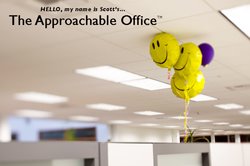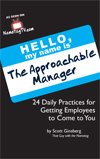 Here’s the most dangerous thought your audience members could EVER have:
Here’s the most dangerous thought your audience members could EVER have:
“Why did I even bother coming to this?”
I learned this lesson after a recent presentation with the American Advertising Federation.
No, I didn’t bomb. Actually, one of my audience members shared a piece of feedback I’d never heard before, but one I’d never forget:
“Scott, what I appreciated most about your presentation was that you never wasted our time.”
Huh. That’s interesting. Never really thought of it that way.
But it makes perfect sense.
HERE’S THE REALITY CHECK: Time is currency. People are busy. And they don’t care about you.
I’m not saying they don’t like you. I’m sure you’re a very interesting, intelligent person.
But self-interest is a powerful force. And whether you’re a salesperson, speaker, writer, entertainer or leader, the last thing you want to do is deliver your message in a way that’s perceived as a waste of people’s time.
Whether you’re faced with one hundred, one thousand– or just one guy sitting across the table – consider these eight strategies for helping YOUR audience get the maximum mileage out of the presentation:
1. What would YOU do? Let’s start with an experiment. First, make a list of three experiences where you watched a movie, attended an event or sat in the audience of a performance and thought to yourself, “Wow. This is a TOTAL waste of my time.”
Next, write down the attributes that contributed to the meaninglessness of each presentation. Then, be honest. Ask yourself if you’re guilty of embodying any of those attributes while YOU present. If not, rock on! If yes, no worries. Consider using that list as an audit to help you prevent wasting people’s time in the future. How boring are you?
2. Put your material to the test. As you prepare your presentation, run each if your ideas, stories, points, statistics, quotations and illustration through the “Nobody Cares about You Test.” It’s pretty simple. Just ask yourself:
“Is this piece of material meaningful (appeals to self-interest) concrete (meat, not fluff) and immediate (actionable and applicable)?”
If not, throw it out. Because if the audience’s answer to what you say is, “Who cares?” you lose. And so do they. Are you speaking with Meaningful Concrete Immediacy?
3. Challenge people to get lost. Here’s a hard truth to swallow: People will forget 99% of the stuff you say during your presentation. But what they WILL remember is what they said to THEMSELVES while listening to what you said.
Your mission is to send people on mental journeys. To help them get productively lost. Now, I’m not suggesting you encourage them to start text messaging during your speech. Instead, remind your audience up front to take notes on what they hear themselves say. Are you helping your audience members listen to themselves?
4. Be scary good. Dave Grohl from Foo Fighters said it best: “When I’m playing a show, my number one goal is to make sure nobody in my audience looks at their watch.” Now, if you’ve ever seen those guys in concert before, you better believe they accomplish that goal during every gig. Because they’re just THAT good. They give their audience permission to be taken over by their performance.
Here are the two best strategies for constant audience captivation:
(a) Get off the stage and walk around the room. People will have no choice but to pay attention to you.
(b) Talk to individual people. As if your speech was a conversation. Look them straight in the eyes.
When you do this, everyone in the room will be engaged. Because when you focus the attention on one; you capture the attention of all. Are your audience members looking at their watches?
5. The slide show isn’t your girlfriend. Having a relationship with the slide and reading it is an insult to the audience’s intelligence. Do this and I guarantee they will both look at their watches AND ask themselves why the hell they bothered to come to your presentation in the first place. Total waste of time.
Your screen is a reference point – not a Magic Eye poster. If you find yourself looking at your slides for more than five seconds, you have too much information on your slides.
Remember: No more than ten words. You should be using mainly pictures anyway. Would your spouse be jealous of the affair you’re having with your PowerPoint?
6. Practice non-rambling spontaneity. Build space in your presentation for the unexpected. Comments. Arguments. Hecklers. They’re all good things. Just let them happen. Welcome useful audience digressions. Some of the best stuff is the stuff you never planned on saying.
At the same time, beware of going off on some eye-rolling tangent that instantly encourages people to start checking their email on their iPhones. Listen closely to what your audience isn’t telling you. Because they might be silently saying, “Dude, we GOT it. Move on to the next point.” Are you enabling the organic without beating dead horses?
7. Save self-gratification for the bathroom. There’s nothing wrong with getting a little personal in your presentation. Nor is it a mistake to share vulnerability from the stage to help build credibility. After all, intimacy via self-disclosure IS what builds trust and receptivity in your audience.
Just remember: There’s huge difference between personalizing and masturbating. One builds an approachable connection with the audience. The other is an ego-driven parade of self-indulgence that your audience can see coming from a mile down the street. No pun in intended.
Your challenge is to honesty gauge whether or not what you’re about to say is (actually) going to improve your audience’s condition, of it’s just going to help YOU maintain an erection. Whom are you (really) giving this speech for?
8. Entertaining, educating and inspiring aren’t enough. If you truly want to maximize every minute of your audience’s time, you need to DISTURB them. I don’t suggest gratuitously showing a bunch of sensationalist pictures to prove your point. Rather, consider embedding emotion into everything. EVERYTHING.
The word “disturb” actually comes from the same Latin derivative as “emotion.” So, your job is to elicit physiological reactions: Audible gasps. Extended laughs. Jaw drops. High fives. Head turns. Forehead slaps. Get the picture?
Your presentation must run the gamut on the emotional spectrum. Topic notwithstanding, your words need to make people mad, sad, glad and rad. Remember: Your audience’s bodies will never lie to you. Emotion is the final arbiter of the effectiveness of your presentation. How are you disturbing people?
In conclusion, I’d like to share an experience of attending a presentation that wasted MY time, along with what I learned from it.
In 2006 I attended a program called “How to Create Promo Videos that Make You More Bookable.” Sounds like a cool session, right?
Well, it would have been. But the speaker, Diane, spent the first TWENTY minutes (of a sixty-minute program) playing nothing but clips of her own clients. And even though her videos were cool to watch, that wasn’t the reason I came to her session. It was billed as “How to Create,” not, “Hey Look What I Created!”
For the record, I thought about saying something. But then I totally chickened out. Wimp.
The guy next to me, on the other hand, didn’t.
Right around minute twenty-one of Diane’s Self-Promotional All You Can Eat Buffet, he jolted up with fire in her eyes. And in the middle of her presentation, he flat out yelled, “Excuse me, Diane? Are actually going to tell us HOW to make a video, or just shamelessly self-promote for the remaining forty minutes?”
Dead silence. Even MY draw dropped to the floor – and I give speeches for a living.
The speaker was dumfounded. And I couldn’t wait to see how she was about to handle the situation.
Eventually, after fumbling over a few words, Diane apologized. She even laughed a little. Because she KNEW that she’d screwed up as the presenter. Naturally, she stopped the videotape, turned up the house lights and delved into the meat of her presentation about HOW to make the video.
HERE’S THE FINAL QUESTION: Do you think the Diane ever won the audience back?
Nope. It was too late. The speaker had already wasted twenty minutes of everyone’s time. And when you’re at an out of town conference that you paid seven hundred dollars to attend, that’s unforgivable.
HERE’S THE FINAL LESSON: As the speaker, you have a responsibility to make an improvement on the energy in the room. To enlarge the people sitting in it. And to assure that when people walk out of that room, they’re better off in some way.
Never waste your audience’s time.
If you do, they won’t invite you back next time.
LET ME ASK YA THIS…
Are your audience members wondering why they bothered to come?
LET ME SUGGEST THIS…
For the list called, “234 Things I’ve Learned about Writing, Delivering and Marketing Speeches,” send an email to me, and you win the list for free!
* * * *
Scott Ginsberg
That Guy with the Nametag
Author, Speaker, Coach, Entrepreneur
[email protected]
 Download a free copy of The Nametag Guy’s (unofficial) 9th book!
Download a free copy of The Nametag Guy’s (unofficial) 9th book!
HELLO, my name is Scott’s…
“Live your name.”
 1. Energy is the best attractor. People might not remember what you said – but they’ll never forget how your energy made them feel.
1. Energy is the best attractor. People might not remember what you said – but they’ll never forget how your energy made them feel. Never the same speech twice.
Never the same speech twice.
 Depending on the situation, you might try any of the following Phrases that Payses to diffuse their negative energy:
Depending on the situation, you might try any of the following Phrases that Payses to diffuse their negative energy:
 The best way to get people to fall love with you is to help them fall in love with themselves first.
The best way to get people to fall love with you is to help them fall in love with themselves first. You can only darken people’s doorsteps so many times.
You can only darken people’s doorsteps so many times. Who’s in hot pursuit of you?
Who’s in hot pursuit of you? 1. Attitude is the best asset. Especially in a down economy. My challenge to you is to approach recessions as opportunities to renew resourcefulness. By blaming the economy you evade responsibility and continue to NOT taking action. Instead, believe that greatness is near.
1. Attitude is the best asset. Especially in a down economy. My challenge to you is to approach recessions as opportunities to renew resourcefulness. By blaming the economy you evade responsibility and continue to NOT taking action. Instead, believe that greatness is near. 1. Behavior is the broadcaster of attitude. Don’t bother announcing to people what kind of attitude you strive to maintain. Anyone who’s even (somewhat) perceptive can already tell. And here’s why: Bodies override mouths, verbs outweigh nouns and actions embody mindsets.
1. Behavior is the broadcaster of attitude. Don’t bother announcing to people what kind of attitude you strive to maintain. Anyone who’s even (somewhat) perceptive can already tell. And here’s why: Bodies override mouths, verbs outweigh nouns and actions embody mindsets.  Woody Allen was wrong.
Woody Allen was wrong. “Why aren’t my people asking me for help?”
“Why aren’t my people asking me for help?” Here’s the most dangerous thought your audience members could EVER have:
Here’s the most dangerous thought your audience members could EVER have: Download a free copy of The Nametag Guy’s (unofficial) 9th book!
Download a free copy of The Nametag Guy’s (unofficial) 9th book!